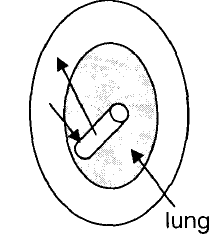This article is to discuss Pneumothorax ,which is an emergency .
We are going to discuss the definition , aetiology, pathology, types , clinical picture , diagnosis and management of the disease .
• Rupture bleb (primary) subpleural emphysematous bullae.
• Severe asthmatic attack, rupture subpleural emphysematous bullae (secondary).
• Rupture of subpleural T.B cavity or lung abscess.
( ii ) Traumatic pneumothorax
• Thoracentesis.
• Mechanical ventilation (ventilators).
• Penetrating chest injuries e.g. car accidents or stab wounds.
( iii ) Artificial pneumothorax
• It was used in treatment of T.B (Collapse therapy) i.e. air is therapeutically introduced into the pleural space (not used now).
input into pleura ---> mild compression on the lung, during expiration, output of air from pleura to bronchus to the outside will occur.
So, there is mild compression on the lung .
• It is a buildup of positive pressure within the pleural space, which rapidly produces severe respiratory embarrassment.
Patients undergoing positive pressure mechanical ventilation are particularly at risk .
• Tension pneumothorax results from a ball-valve mechanism at the site of the air leak, which allows air to enter but not leave the pleural space air e.g. due to trauma.
• This leads to progressive collapse of the lung, a contralateral shift of the mediastinal structures, and reduced blood flow to the right side of the heart, impairing cardiovascular function as well as lung function.
2 Anxiety (sense of impending death)
3 Severe dyspnea with severe cases, dry cough.
4 Shock , cyanosis and right sided heart failure with tension pneumothorax
5 Manifestations of the cause.
Severe :
Inspection : Movement is diminished.
Palpation : Decreased TVF & expansion, mediastinal shift to the opposite side.
Percussion : Hyperresonance
Auscultation : - Decreased air entery (Decreased intensity of breath sounds)
- Amphoric breathing in open and tension types.
- Pneumothorax click in left sided cases.
• Massive pulmonary embolism
• Extensive myocardial infarction.
• Dissecting aortic aneurysm
pneumothorax area because this technique increases the contrast between the lung
and the pleural space.
2- Measurement of the intrapleural pressure by manometry.
3- CT scan chest.
2- A small spontaneous pneumothorax often resolves by itself.
3- Intercostal tube under H20 seal for a more severe or a secondary pneumothorax for reexpansion of the lung.
This tube is inserted for 24-28 after the lung re-expansion.
In recurrent spontaneous pneumothorax (after 3 or more occurrences), pleurodesis can be done by intrapleural injection of glucose or tetracycline, this also can be used in malignant effusion resistant to treatment.
We are going to discuss the definition , aetiology, pathology, types , clinical picture , diagnosis and management of the disease .
Definition of Pneumothorax :
Presence of air in the pleural space, If the accumulating air is large enough, the underlying lung may become collapsed and functionless.Etiological types of Pneumothorax :
(i )Spontaneous pneumothorax• Rupture bleb (primary) subpleural emphysematous bullae.
• Severe asthmatic attack, rupture subpleural emphysematous bullae (secondary).
• Rupture of subpleural T.B cavity or lung abscess.
( ii ) Traumatic pneumothorax
• Thoracentesis.
• Mechanical ventilation (ventilators).
• Penetrating chest injuries e.g. car accidents or stab wounds.
( iii ) Artificial pneumothorax
• It was used in treatment of T.B (Collapse therapy) i.e. air is therapeutically introduced into the pleural space (not used now).
Pathological types of Pneumothorax
(according to the intrapleural pressure):I. Closed Pneumothorax
Air within pleura with no communication with the atmosphere e.g. Rupture bleb ---> mild increase in pleural pressure, it is usually absorbed (regressive)II. Open Pneumothorax
e.g. Trauma --> bronchopleural fistula (air within pleura communicating with the atmosphere) so, with inspiration ---> airinput into pleura ---> mild compression on the lung, during expiration, output of air from pleura to bronchus to the outside will occur.
So, there is mild compression on the lung .
III. Tension pneumothorax
= (valvular mechanism) the most severe• It is a buildup of positive pressure within the pleural space, which rapidly produces severe respiratory embarrassment.
Patients undergoing positive pressure mechanical ventilation are particularly at risk .
• Tension pneumothorax results from a ball-valve mechanism at the site of the air leak, which allows air to enter but not leave the pleural space air e.g. due to trauma.
• This leads to progressive collapse of the lung, a contralateral shift of the mediastinal structures, and reduced blood flow to the right side of the heart, impairing cardiovascular function as well as lung function.
Clinical picture of Pneumothorax
Symptoms
1 Sudden onset of chest pain, the patient may feel that something ruptured e.g (rupture bleb or emphysematous bulla).2 Anxiety (sense of impending death)
3 Severe dyspnea with severe cases, dry cough.
4 Shock , cyanosis and right sided heart failure with tension pneumothorax
5 Manifestations of the cause.
Signs
Mild : No signs (diagnosed by X ray)Severe :
Inspection : Movement is diminished.
Palpation : Decreased TVF & expansion, mediastinal shift to the opposite side.
Percussion : Hyperresonance
Auscultation : - Decreased air entery (Decreased intensity of breath sounds)
- Amphoric breathing in open and tension types.
- Pneumothorax click in left sided cases.
Differential Diagnosis of chest pain + shock
• Tension pneumothorax• Massive pulmonary embolism
• Extensive myocardial infarction.
• Dissecting aortic aneurysm
Investigations to diagnose Pneumothorax :
1- X-ray chest, if obtained during expiration, may help to demonstrate smallpneumothorax area because this technique increases the contrast between the lung
and the pleural space.
2- Measurement of the intrapleural pressure by manometry.
3- CT scan chest.
Treatment of Pneumothorax
1- management of the Cause.2- A small spontaneous pneumothorax often resolves by itself.
3- Intercostal tube under H20 seal for a more severe or a secondary pneumothorax for reexpansion of the lung.
This tube is inserted for 24-28 after the lung re-expansion.
In recurrent spontaneous pneumothorax (after 3 or more occurrences), pleurodesis can be done by intrapleural injection of glucose or tetracycline, this also can be used in malignant effusion resistant to treatment.



